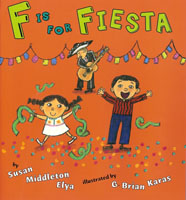Reviews
School Library Journal
Kindergarten-Grade 2-This story of a Hispanic boy's birthday party starts with A is for adornos (decorations) hung up by Papá. and ends with Z is for zorro (fox) from Dad with a kiss. A glossary at the books beginning helps with the pronunciation and meaning of the Spanish words...Karas's illustrations definitely set the mood with reds, greens, purples, yellows, pinks, and oranges that are bright and bold but never garish. They also do a good job of giving clues to the meaning of the Spanish words. -Catherine Callegari, Gay-Kimball Library, Troy, NH
Kirkus Reviews
The team that brought readers Oh, No, Gotta Go! (2003), with its seamless weaving of Spanish into English and its richly colored illustrations featuring big heads and little bodies, returns with a birthday story in the form of an alphabet book. The strictures of the form almost necessarily rein in the wild invention of the earlier offering, but Elya's latest is still far more fluid and vibrant than most alphabet titles. Employing the Spanish alphabet, with "extra" letters ch, ll, - and rr, and expanding her verses to accommodate additional narrative elements, Elya covers both the preparations for the party and the party itself, with its distinctly Latino flavor. The Spanish is mostly confined to the alphabet words that are explained by context, a glossary that precedes the story and the illustrations. Karas employs flat backgrounds, upon which the characters move and the toys, furnishings and food are highlighted. Seen simply as a birthday story, this is fluid and appealing, but not essential. As an alphabet book incorporating the Spanish language and Latino culture, however, it shines. (Picture book. 2-7)
Booklist
K-Gr. 2. Bilingual classrooms, and teachers seeking materials for Cinco de Mayo activities, will seize this small, square abecedarian book, which incorporates Spanish vocabulary words from A to Z into a singsong, predominantly English-language narrative about a child's birthday fiesta: " S is for salsa, a sauce and a dance. T is for tarjetas from uncles and aunts." At their best, Elya's verses bounce as easily between languages as they did in Oh, No, Gotta Go! (2003), which was also buoyantly illustrated by Karas. Sometimes the strain of adhering to both the theme and the verse structure is obvious, but the backdrop of a familiar, fun-filled occasion may smooth the way to learning--and even very silly rhymes can be useful mnemonics. A glossary with pronunciations (but no articles) opens the book, along with a discussion of the Spanish alphabet, which here includes rr as well as the usual ch, ll, n . The book's petite size will limit its read-aloud use to smaller groups. -Jennifer Mattson
Topeka's Capital Journal
Susan Middleton Elya's "F is For Fiesta" describes a lively birthday party, featuring the 30 letters of the Spanish alphabet.
Before the party begins, "A" is for adornos hung by Papá while "B" is for the biscochitos Mamá bakes.
Brian Karas' delightful illustrations draw young readers into a party, complete with dulces (sweets), globos (balloons), juguetes (toys) and a bright star-shaped piñata filled with candy. this joyous alphabet book includes a glossary of translations and would make a great birthday gift for any small niños.
Bulletin of the Center for Children's Books
It's party time for a little boy marking his fourth cumpleaños -- birthday -- and a run through the Spanish alphabet highlights food (biscochitos, churros, dulces), activities (guitarra strumming, piñata smashing, salsa dancing), and of course, gifts (a melodic xilófono, a stuffed oso -- bear -- and zorro -- fox) that make the day special.
The alphabet format pretty much precludes any plot, and the text is little more than a pleasant compendium of festive references. However, the round-headed cast, which seems unusually solid and grounded by G. Brian Karas standards, cavort in appropriately celebratory colors, and through the rhymed couplets are somewhat forced, they move the party along briskly. A glossary with pronunciation guide reviews all vocabulary, and an author's note discusses the different between the English and Spanish alphabets. Cultural insiders and outsiders are equally welcome, and emergent Spanish readers of any ethnic background may find this an inviting readalong. EB.
|







